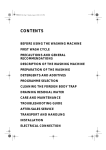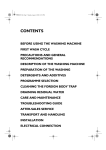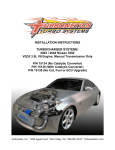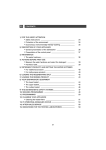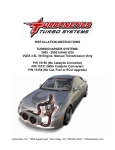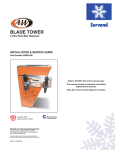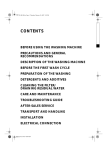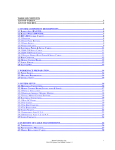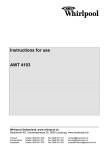Download Smeg GB ST L80 Washer User Manual
Transcript
GB STL 80 PROGRAMME CHART A. Temperature Selection Knob B. “On/Off” Button C. “Spin Speed Reduction” Button ❉ : option / Yes: dosing required 1) C A Care Labels Programme B Type of wash / Notes 2) Max. Detergents and additives load Prewash Main Softener Bleach Wash Prelavaggio cotone Prelavaggio sintetici Prelavaggio delicati Cotton Cotton short Synthetic Synthetic short Delicate Heavily soiled bed linen, table linen and underwear, towels, shirts etc. made of cotton and linen. Heavily soiled blouses, shirts, overalls etc. made of polyester (Diolen, Trevira), polyamide (Perlon, Nylon) or blends with cotton. Rinse Hold Special Options Temperature Intensive Half Spin Speed Rinse Load Reduction Esclusione Risciacquo Mezzo Centrifuga Intensivo Carico kg Cotton with prewash Synthetic with prewash Delicate with prewash Do not use liquid detergents. For improved garment care, spin speed is zero in this programme. °C rpm ❉ Max. 95 800 ❉ ❉ Max. 60 800 — — ❉ Max. 40 800 ❉ ❉ ❉ ❉ Max. 95 800 — ❉ ❉ ❉ ❉ Max. 60 800 ❉ — ❉ ❉ ❉ ❉ Max. 60 800 Yes ❉ — ❉ ❉ ❉ ❉ Max. 60 800 — Yes ❉ — ❉ — — ❉ Max. 40 800 1.0 — Yes ❉ — ❉ — — ❉ Max. 40 800 1.0 — Yes ❉ — ❉ — — ❉ Max. 30 0 2) 2.0 — — ❉ — ❉ ❉ ❉ — — 800 5.0 — — ❉ — ❉ ❉ ❉ ❉ — 800 — — — — — — — — — — — — — — — — — — — — — ❉ ❉ — — — — 800 800 5.0 Yes 1) Yes ❉ ❉ ❉ ❉ ❉ 2.0 Yes 1) Yes ❉ — ❉ ❉ Heavily soiled curtains and delicate clothing, dresses, skirts, shirts and blouses. 1.5 Yes 1) Yes ❉ — ❉ Cotone normale Normally soiled bed linen, table linen and underwear, towels, shirts etc. made of cotton and linen. 5.0 — Yes ❉ ❉ Cotone leggero Sintetici normale Sintetici leggero Slightly to normally soiled bed linen, table linen and underwear, towels, shirts etc., made of cotton and linen. Slightly to normally soiled blouses, shirts, overalls etc. made of polyester (Diolen, Trevira), polyamide (Perlon, Nylon) or blends with cotton. Slightly soiled overalls and sportswear made of cotton, polyester, polyamide and blends with cotton. 3.0 — Yes ❉ 2.0 — Yes 1.5 — Curtains and delicate clothing, dresses, skirts, shirts and blouses. 1.5 Delicati — Only woollens with a felt-free finish, labelled with the woolmark and identified as machine washable. If you select “Rinse Hold” do not leave items to soak for too long. Textiles made of silk, linen, wool and viscose marked as “handwashable”. If you select “Rinse Hold” do not leave items to soak for too long. No spinning. Same as the last two rinses and the final spin in the "Synthetic" programme. Programme for treating wash with starch or softener. Same as the last rinse and the final spin in the “Cotton” programme. Programme for treating wash with starch or softener. In this programme spinning is intensive. Same as the spin cycle in the “Cotton” programme. Gentle spin Centrifuga breve — In this programme spinning is gentle. Same as the spin cycle in the “Wool” programme. 5.0 2.0 Drain Scarico — Drain only - no spinning. Alternative method of terminating programme after “Rinse Hold”. — Wool Lana Silk Seta Rinse + Gentle Risciacquo Spin Centrifuga breve Risciacquo Rinse + Spin Centrifuga Spin Centrifuga — — Max. Spin Speed — N.B.This machine is controlled by sensors. Please avoid excessive detergent dosing. 5019 612 10095 CONSUMPTION DATA Temperature Selector Load Water Energy Approx. Programme Duration (hours : minutes) Programme (°C) (kg) (l) (kWh) Cotton 95 5.0 63* 1.80 2:05 Cotton 60 5.0 55 0.95 2:05 Cotton 40 5.0 55 0.55 2:05 Synthetic 60 2.0 56 0.80 1:30 Synthetic 40 2.0 56 0.40 1:30 Delicate 40 1.5 60 0.55 0:45 Wool 40 1.0 60 0.50 0:40 Silk 30 1.0 60 0.30 0:50 Prewash cycle increases programme duration approximately 15 min. Consumption values were measured in normalized conditions in compliance with standard IEC/EN 60 456. Consumption data in the home may vary with respect to the values in the table in relation to the water supply pressure and temperature, the load and the type of wash. The data on the “Energy Label” refer to the programme “Cotton 60°C”. * To reduce the water temperature, some cold water is added at the end of the main wash cycle, before the pump drains the water out. PREPARATION OF WASH CYCLE SELECT THE DESIRED OPTION 1. Load the machine, close the drum flaps and check that they are properly locked. 2. Add detergents and additives into the dispenser to no more then the “MAX” level mark, as follows: • Programme with pre and main wash • Main wash programme without prewash • Fabric softeners and conditioners • Chlorine bleach • Stain remover agents • Anti-scale agents (if necessary) 3. Turn the programme selector knob to the desired programme. 4. Turn the temperature selector knob to the desired temperature. 5. Press the spin speed reduction button, if desired. Selecting or deselecting an option can be done at any time during the programme. The option will be applied as long as the corresponding programme phase has not been executed yet. • If you want to cancel the final spin, select the rinse hold option and drain the water after the cycle has finished (see Appliance in “Rinse Hold”). • If you do not wish to spin the clothes, press the “Rinse Hold” button • The laundry remains in the last rinse water without progressing to the final spin cycle to avoid creasing and prevent colours from fading. • This option is particularly recommended for the “Synthetic” or “Delicate” programmes. • This function is particularly useful if you want to “Intensive Rinse” button • One rinse cycle is added to ensure a more intensive rinse. • This option is particularly suitable for areas with very soft water, washing baby linen and people with detergents allergies. “Half Load” button • Can be used for small loads and lightly soiled laundry. • Reduces the water consumption especially during the rinses. PROGRAMME START Turn on the tap and press the “On/Off” button. The indicator light of the “On/Off” button lights up. Note: If there is a power interruption or if the appliance is disconnected during the cycle, the programme will run again from the point where it was interrupted. END OF WASH CYCLE CHANGE THE PROGRAMME DURING THE WASH CYCLE 1. Switch off the machine by pressing the “On/Off” button. 2. Select the new programme. 3. Start programme by pressing the “On/Off” button again. PAUSE/INTERRUPT A PROGRAMME If, for any reason, you wish to interrupt the programme for a certain time and continue it later: 1. Press the “On/Off” button. 2. After the desired pause, press again the “On/Off” button. CANCEL PROGRAMME 1. Switch off the machine by pressing the “On/Off” button. 2. Set the programme selector to “Drain”. 3. Press the “On/Off” button again to start the “Drain” programme. • The programme selector knob is in the Stop position “ ”. 1. Press the “On/Off” button to switch off the machine. 2. Cancel the options. 3. Turn the tap off. 4. Wait for the door to unlock (about 1 minute). 5. Open the door and the drum flaps and unload the machine. postpone spinning to a later time, or if you want to drain only. Appliance in “Rinse Hold”: • Press the “Rinse Hold” button again: the programme will terminate automatically with the selected spin cycle. “On/Off” button, turn the programme selector knob to the “Drain” programme and press the “On/Off” button again. 5019 612 10095 IFU_Alpha_Sc1-mech_GB.fm Page 1 Wednesday, March 30, 2005 6:52 PM CONTENTS BEFORE USING THE WASHING MACHINE FIRST WASH CYCLE PRECAUTIONS AND GENERAL RECOMMENDATIONS DESCRIPTION OF THE WASHING MACHINE PREPARATION OF THE WASHING DETERGENTS AND ADDITIVES PROGRAMME SELECTION CLEANING THE FOREIGN BODY TRAP DRAINING RESIDUAL WATER CARE AND MAINTENANCE TROUBLESHOOTING GUIDE AFTER-SALES SERVICE TRANSPORT AND HANDLING INSTALLATION ELECTRICAL CONNECTION Black process 45.0° 100.0 LPI IFU_Alpha_Sc1-mech_GB.fm Page 2 Wednesday, March 30, 2005 6:52 PM BEFORE USING THE WASHING MACHINE 1.Remove the packaging and check 6.Electrical connection a. Cut and remove the shrink-wrap. b.Remove the top protection and the protective corners. c. Remove the bottom protection by tilting and turning the washing machine on one rear bottom corner. d. Open the lid by pressing it slightly down while raising the handle. Remove the polystyrene cushion. e. Remove the blue protective film from the panel (depending on model). • After unpacking, make sure that the washing machine is undamaged. If in doubt, do not use the washing machine. Contact After-Sales Service or your local retailer. • Keep the packaging materials (plastic bags, polystyrene parts, etc.) out of reach of children; they are potentially dangerous. • Electrical connections must be carried out by a qualified technician in compliance with the manufacturer’s instructions and the current standard safety regulations. • The technical data (voltage, power and fuses) are given on the rating plate on the rear of the washing machine. • The washing machine must be connected exclusively by means of a socket with an earth connection in accordance with current regulations. The washing machine must be earthed by law. The manufacturer declines all liability for damage to persons or property deriving directly or indirectly from failure to observe the directions. • Do not use extension leads or multi sockets. • Before any maintenance on the washing machine disconnect it from the mains supply. • Access to the mains plug or to disconnection from the mains supply via a double-pole switch must be ensured at all times following the installation. • Do not operate the washing machine if it has been damaged during transport. Inform the After-Sales Service. • Mains cable replacement is only to be carried out by After-Sales Service. • The washing machine must be connected to an effective earthing installation, in compliance with the regulations in force. In particular, washing machines installed in premises containing a shower or a bath must be protected by a differential residual current device of at least 30 mA. Earthing the washing machine is obligatory under the law. The manufacturer declines all liability for damage to persons or property deriving either directly or indirectly from failure to observe the directions above. • The washing machine may only be used in the household for the prescribed uses. 2.Remove the transport bracket • The washing machine is fitted with transport screws and a transport bracket to prevent damage during transport. Before using the washing machine you must remove the transport bracket (see “Installation/Remove the transport bracket”). 3.Install the washing machine • Place the washing machine on a flat and stable floor surface. • Adjust the feet to ensure that the machine is stable and level (see “Installation/Adjust the feet”). 4.Water supply • Connect the water supply inlet hose in accordance with the regulations of your local water company (see “Installation/Connect the water inlet hose”). • Water supply: Cold water only • Tap: 3/4” threaded hose connection • Pressure: 100-1000 kPa (1-10 bar). 5.Drain hose • Connect the drain hose to the siphon or hook it over the edge of a sink with the “U” bend (see “Installation/Connect the water drain hose”). • If the washing machine is connected to a built-in drainage system, ensure the latter is equipped with a vent to avoid simultaneous loading and draining of water (siphoning effect). Dimensions: Width: 400 mm Height: 900 mm Depth: 600 mm GB 2 Black process 45.0° 100.0 LPI IFU_Alpha_Sc1-mech_GB.fm Page 3 Wednesday, March 30, 2005 6:52 PM FIRST WASH CYCLE We recommend that the first wash cycle be carried out empty. This will remove any residual water used in the factory checks. 1. Turn on the tap. 2. Close the drum flaps. 3. Pour a small amount of detergent (about 30 ml) into the detergent dispenser . 4. Select a short programme (see programme chart). 5. Switch on the machine by pressing the “On/Off” button. PRECAUTIONS AND GENERAL RECOMMENDATIONS 1.Packing • The packaging materials are 100% recyclable and bear the recycling symbol . Adhere to local regulations when disposing of packaging material. 2.Energy saving tips • Achieve the best use of energy, water, detergent and time by using the recommended maximum load size. • Do not exceed the detergent dosages indicated in the manufacturer’s instructions. • The Eco Ball - a special system in the outlet - will prevent detergent loss from the drum to avoid detergent loss into the environment. • Use “Prewash” for heavily soiled laundry only! Save detergent, time, water and energy consumption by not selecting “Prewash” for slight to normally soiled laundry. • Pretreat stains with stain remover or soak dried in stains in water before washing to reduce the necessity of a hot wash program. • Save energy by using a 60°C instead of a 90°C wash programme or a 40°C instead of a 60°C wash programme. • Save energy and time by selecting a high spin speed to reduce the water content in laundry before using a tumble dryer (for machines with adjustable spin speed). 3.Disposing of packaging and old washing machines • This appliance is marked according to the European directive 2002/96/EC on Waste Electrical and Electronic Equipment (WEEE). By ensuring this product is disposed of correctly, you will help prevent potential negative consequences for the environment and human health, which could otherwise be caused by inappropriate waste handling of this product. The symbol on the product, or on the documents accompanying the product, indicates that this appliance may not be treated as household waste. Instead it shall be handed over to the applicable collection point for the recycling of electrical and electronic equipment. Disposal must be carried out in accordance with local environmental regulations for waste disposal. For more detailed information about treatment, recovery and recycling of this product, please contact your local city office, your household waste disposal service or the shop where you purchased the product. • The washing machine is built from reusable materials. It must be disposed of in compliance with current local waste disposal regulations. • Before scrapping, cut off the power cable so that the washing machine cannot be connected to the mains. • Remove detergent from compartment if you intend scrapping your washing machine. 4.Child safety • Children must not be allowed to play with or in the washing machine. 5.General recommendations • Do not leave the washing machine connected when not in use. Turn off the tap. • Before cleaning or carrying out maintenance switch off the washing machine and disconnect it from the mains supply. • To clean the outside of the washing machine, use a neutral detergent and a damp cloth. • Do not use abrasive detergents. • Do not attempt to force the lid open. • If necessary, the power cable may be replaced with an identical one obtained from our AfterSales Service. The power cable must only be replaced by a qualified technician. 6.EC Declaration of Conformity • This washing machine has been designed, constructed and distributed in compliance with the safety requirements of EC Directives: 73/23/EEC Low Voltage Directive 89/336/EEC EMC Directive 93/68/EEC CE Marking Directive GB 3 Black process 45.0° 100.0 LPI IFU_Alpha_Sc1-mech_GB.fm Page 4 Wednesday, March 30, 2005 6:52 PM DESCRIPTION OF THE WASHING MACHINE 1. Lid 1 2. Detergent dispenser 3. Drum flaps 2 4. Pump and foreign body trap 5. After-Sales Service sticker (behind the foreign body trap cover) 3 6. Mobility lever (depending on model) • To move the washing machine: pull the handle out a little bit by hand and pull it out to the stop with the foot. 7. Adjustable feet 4 5 6 7 PREPARATION OF THE WASHING Sort the laundry 1. Sort the laundry according to… • Type of fabric / care label symbol Cottons, mixed fibres, easy care/synthetics, wool, handwashed items. • Colour Separate whites and coloureds. Wash new coloured items separately. • Size Wash items of different sizes in the same load to improve efficiency and distribution in the drum. • Fabric delicacy Wash delicate articles separately: use a special programme for Pure New Wool , curtains and other delicates. Always remove curtain glides or wash curtains with the glides inside a cotton bag. Use the special program for handwash fabrics. Wash stockings, belts and other small items or articles with hooks (e.g. bras) in special cotton bags for washing machines or in zipped pillow cases. 2.Empty pockets Coins, safety pins and similar items can damage your washing machine drum and tub. 3.Fasteners Close zips and fasten buttons or hooks; loose belts or ribbons should be tied together. Stain removal • Blood, milk, egg and other organic substances are generally removed by the enzyme phase of the programme. • To remove red wine, coffee, tea, grass and fruit stains etc. add a stain removing agent in detergents dispenser compartment or chlorine bleach in compartment (depending on model). • Particularly stubborn stains should be treated before the wash. Dyeing and bleaching Products usually consist of dye colour, fixing agent and salt. Pour the dye colour, the fixing agent and then the salt directly into the empty drum. Load the laundry only afterwards. • Only use dyes and bleaches recommended for washing machines. • Follow the manufacturer’s instructions. • Plastic and rubber parts of the machine may be stained by dyes or bleaches. Starching • Dissolve/dilute the starch powder or liquid in approximately 80 - 100 ml water outside the washing machine in a small container. Load the washing machine and close the drum flaps. Pour the dissolved starch into the softener chamber of the detergent dispenser. Then close the lid, chose programme “Rinse and Spin” and start. GB 4 Black process 45.0° 100.0 LPI IFU_Alpha_Sc1-mech_GB.fm Page 5 Wednesday, March 30, 2005 6:52 PM Loading the laundry 1. Open the machine lid. 2. Open the drum by pressing the small flap (2a) or the push button (2b) - depending on model - and holding the large flap. For the drum opening shown on 2c, you just have to press the push button, without holding the large flap. 1 3. Place the items of laundry in the drum one by one without compressing them. Follow loads recommended in the “programme chart”: overloading will result in unsatisfactory washing results and creased laundry. 4. To close the drum, hold both doors in the middle again. ATTENTION: Make sure that the drum flaps are properly locked (for model as shown on photo 2c: the button must protrude out beyond the edge of the big door flap) 2a 2b 2c 3 GB 5 Black process 45.0° 100.0 LPI IFU_Alpha_Sc1-mech_GB.fm Page 6 Wednesday, March 30, 2005 6:52 PM DETERGENTS AND ADDITIVES Choice of the right detergents and additives Dosage The type of detergent depends on: • type of fabric (cottons, easy care/synthetics, delicate items, wool). Note: use only specific detergents for wool. • colour; • washing temperature; • degree and type of soiling. Notes: Whitish residues on dark fabrics are caused by insoluble detergents components used in modern phosphate-free powder detergents. If you notice this problem, shake or brush the affected items or use a liquid detergents. Keep detergents and additives in a dry place and out of reach of children. Use only detergents and additives specifically produced for domestic washing machines. If you use descaling agents, dyes or bleaches, make sure they are suitable for washing machine use. Descaler could contain components that can attack parts of your washing machine. Do not use solvents (turpentine, benzine, etc.). Do not machine wash fabrics that have been treated with solvents or flammable liquids. Follow the instructions on the detergent pack in relation to: • the degree and type of soiling; • the size of the load; - full load: follow the detergent manufacturer’s instructions; - half load: 3/4 the amount used for a full load; - minimum load (about 1 kg): half the amount used for a full load; • water hardness in your area (ask for information from your water company): soft water requires less detergent than hard water. Notes: Too much detergent can result in excess foam formation, and the reduction of washing efficiency. If the washing machine detects excessive foam it may prevent spinning. Insufficient detergent may result in: grey laundry, deposits on the drum, tub and heater. When using concentrated fabric softeners, add water in the detergents dispenser up to “MAX” level mark. To prevent dispensing problems when using highly concentrated powder and liquid detergents, use the special detergent ball or bag supplied with the detergent and place it inside the drum. WATER HARDNESS CHART WATER HARDNESS CATEGORY 1 2 3 4 CHARACTERISTICS GERMAN °dH FRENCH °fH ENGLISH °eH soft medium hard very hard 0-7 7-14 14-21 over 21 0-12 12-25 25-37 over 37 0-9 9-17 17-26 over 26 Filling up with detergents and additives The dispenser will have three or four compartments depending on model. Pour in the detergent: • Washing powder for prewash and main wash • Washing powder for main wash without prewash • Fabric softeners and starch products, no more than to “MAX” mark. • Chlorine bleach, no more than to “MAX” mark. (only four compartments model) • Stain removers • Water softeners (water hardness class 4) • Starch (dissolved in water) Be careful not to fill more than the “MAX” level mark. Do not use liquid detergents for programmes with prewash. For programmes without prewash and temperatures from cold to 40° C, it is recommended to use liquid detergents to avoid whitish residues on the laundry. GB 6 Black process 45.0° 100.0 LPI IFU_Alpha_Sc1-mech_GB.fm Page 7 Wednesday, March 30, 2005 6:52 PM PROGRAMME SELECTION Preparation of wash cycle 1. Load the machine, close the drum flaps and check that they are properly locked. 2. Add detergents and additives into the dispenser to no more than the “MAX” level mark. Please refer to “Detergents and additives”. 3. Turn the programme selector knob to the desired programme. 4. Turn the temperature selector knob (if available) to the desired temperature. 5. Turn the spin speed selector knob (if available) to the desired spin speed. If the spin speed “0” is selected, the final spin is cancelled, but not intermediate spins. The programme ends with a drain cycle. 6. Select the desired options as described in the Programme Chart. Programme start Switch on the washing machine- the indicator lights up. Note: If there is a power interruption or if the washing machine is disconnected during the cycle, the programme will run again from the point where it was interrupted. End of wash cycle • The programme selector knob is in the Stop position. 1. Switch off the washing machine. 2. Cancel the options. 3. Turn the tap off. 4. Wait for the lid to unlock (about 1 minute). 5. Open the lid and the drum flaps and unload the machine. Change the programme during the wash cycle 1. Switch off the washing machine. 2. Select the new programme. 3. Start the programme by switching on the machine. Pause/Interrupt a programme If for any reason you wish to interrupt the programme for a certain time and continue it later: 1. Switch off the machine. 2. After the desired pause turn on the machine again. Cancel programme 1. Switch off the washing machine. 2. Set the programme selector to “Drain”. 3. Switch on the machine again to start the “Drain” programme. GB 7 Black process 45.0° 100.0 LPI IFU_Alpha_Sc1-mech_GB.fm Page 8 Wednesday, March 30, 2005 6:52 PM CLEANING THE FOREIGN BODY TRAP The washing machine is provided with a self-cleaning pump. The foreign body trap keeps objects like buttons, coins, safety-pins etc. which have been left in the laundry. 1. Unplug the washing machine. 2. Open the foreign body trap cover with a coin. 3. Place a bowl beneath it. 4. Turn the foreign body trap slowly anti-clockwise until the grip is vertical; do not remove it as yet. 5. Wait until all the water has drained out. 6. Now unscrew the foreign body trap completely and extract it. 7. Remove any foreign items from the foreign body trap. 8. Make sure the pump impeller (in the housing behind the foreign body trap) is not obstructed. 9. Insert the foreign body trap again and screw it fully down in a clockwise direction to the stop (until the grip is horizontal). 10. Pour 0.5 litres of water into the machine via the drum and check that water does not leak from the foreign body trap. 11. Close the foreign body trap cover. 12. Reconnect the washing machine. Check the foreign body trap if the washing machine is not draining correctly or if it fails to perform spin cycles. The machine has safety device which stops the washing machine before each filling when water was not removed completely from the tub in previous part of washing programme. Check the foreign body trap regularly, two or three times a year and clean it if necessary. IMPORTANT: Make sure the water has cooled before emptying the foreign body trap. GB 8 Black process 45.0° 100.0 LPI IFU_Alpha_Sc1-mech_GB.fm Page 9 Wednesday, March 30, 2005 6:52 PM DRAINING RESIDUAL WATER When should I drain residual water (draining problem)? • Before transporting (moving) the machine. • If the washing machine is installed in a room subject to subzero temperatures. It is best in this case to drain the machine after every wash. 1. Stop the washing machine and unplug it. 2. Turn off the tap, disconnect the water supply hose from the machine and allow the water to drain into a basin. 3. Open the foreign body trap, let the water drain into a small shallow basin and close the trap. 4. Release the drain hose then open the fixing clip located at the rear of the machine (see arrow A). 5. Let the residual water flow into a shallow basin. 6. Wait until the flow stops. 7. Fix the drain hose again with the clip and replace it with the Ubend. 8. Reconnect the water supply hose and the power plug. Important: • After draining the residual water, screw on the machine’s water supply hose by hand. Check water-tightness of washing machine connections by turning the tap completely on. CARE AND MAINTENANCE Detergent dispenser 1. Push in the buttons on each side of the dispenser. 2. Pull the dispenser towards you and remove. A small quantity of water can remain in the dispenser. It is advisable to carry the dispenser in an upright position. 3. Wash the dispenser using running water. You can also remove the siphon caps in the dispenser for cleaning. 4. Replace the siphon caps in the dispenser (if removed). Make sure that they lock in place. 5. Replace the dispenser by locating the bottom tabs in the lid holes and pivot until both of the upper buttons lock. Note: ensure that the detergent dispenser is correctly reinstalled. GB 9 Black process 45.0° 100.0 LPI A IFU_Alpha_Sc1-mech_GB.fm Page 10 Wednesday, March 30, 2005 6:52 PM Water inlet hose filter Check and clean regularly (at least two or three times a year). 1. Unplug the washing machine. 2. Turn off the tap. 3. Unscrew the hose from the tap. 4. Carefully clean the filter located at the end of hose, without assembling it, for example with a tooth-brush. Note: For machines equipped with hose type “A”, it must not be submerged in water. 5. Screw the flexible hose back onto the tap by hand. Do not use pliers (risk of squashing the joint). A 6. Turn on the tap and check that the connections are watertight. 7. Plug the washing machine back in. Recovering an object that falls between the drum and the tub If an object accidentally falls between the drum and the tub, you can recover it thanks to one of the removable drum blades: 1. Unplug the washing machine. 2. Remove the laundry from the drum. 3. Close the drum flaps and turn the drum a half-turn. 3 4. Using the screwdriver press the plastic end while sliding the blade from left to right. 5. It will fall into the drum. 6. Open the drum: you can recover the object through the hole in the drum. 7. Refit the blade from inside the drum: Position the plastic tip above the hole on the right side of the drum. 4 8. Then slide the plastic blade from right to left until it clips. 9. Close the drum flaps again, turn the drum through half a turn and check the positioning of the blade at all its anchorage points. 10. Plug the washing machine in again. 4 7 GB 10 Black process 45.0° 100.0 LPI IFU_Alpha_Sc1-mech_GB.fm Page 11 Wednesday, March 30, 2005 6:52 PM Washing machine exterior and control panel Lid seal • Clean with a soft damp cloth. • If necessary, a neutral household cleaner can be applied (do not use aggressive or abrasive products). • Clean from time to time with a damp cloth. Water inlet hose(s) • Check the hose regularly for brittleness and cracks. Replace if necessary. TROUBLESHOOTING GUIDE This washing machine is equipped with automatic safety functions which detect and diagnose faults at an early stage and allow you to react appropriately. Often, however, the faults detected are small enough to be solved in a matter of minutes. For example: *The washing machine does not start, no lamp lights up. Check whether: • the washing machine is plugged in. • the wall socket is functioning correctly (use a table lamp or similar). *The washing machine does not start, but the pilot lamp is on. Check whether: • the washing machine lid is properly closed. Open and close it again. • a programme has been selected. • the water tap is open. *The washing machine stops during the programme. Check whether: • the “Rinse Hold” button is pressed: terminate this option by pressing the button again. • the water tap is open. • the pump/foreign body trap is blocked (see “Cleaning the Foreign Body Trap”). • the Water stop could be activated (see “Water stop fault”). Reconnect the washing machine. Turn on the machine to continue with the programme (do not add detergent for this programme). *The washing machine does not drain out the water. Switch off the washing machine and unplug it. Check whether: • the “Rinse Hold” button is pressed. Terminate this option. • the drain hose is kinked (see “Installation”). • the pump impeller is obstructed (see “Cleaning the foreign body trap”). • the water in the drain hose is frozen. If water has remained in the drum, you can drain it by following the instructions in the chapter “Draining residual water”. IMPORTANT: Before draining, allow the wash water to cool down. Reconnect the washing machine. Turn on the machine to continue with the programme (do not add detergent for this programme). If the fault re-occurs, contact After-Sales Service (see “After-Sales Service”) *Detergent and additive product residues remain in dispenser at end of wash. *Insufficient or no water supply. Switch off the washing machine and unplug it. Check whether: • the water tap is fully turned on, and the water supply pressure is sufficient. • the water inlet hose is kinked. • the mesh filter in the water inlet hose is blocked (see “Care and maintenance”). • the water in the water inlet hose is frozen. • the washing machine has a safety hose and the safety valve is open (red indicator in the safety valve inspection window). In this case replace it with a new safety hose. Check whether: • the detergent dispenser is properly installed and is not blocked (see “Care and maintenance”). • the foreign body trap in the water inlet hose is not blocked (see “Care and maintenance”). *The washing machine vibrates during the spin cycle. Check whether: • the washing machine is levelled and all the feet are adjusted (see “Installation”). • the transport bracket has been removed. Before starting up the washing machine, the transport bracket MUST be removed (see “Installation”). GB 11 Black process 45.0° 100.0 LPI IFU_Alpha_Sc1-mech_GB.fm Page 12 Wednesday, March 30, 2005 6:52 PM *Final spin results are poor. Water stop fault (depending on model). Note: the washing machine has an unbalance detection and correction system. If individual heavy items are loaded (a bathrobe, for example), this system may reduce the spin speed automatically or interrupt the spin if it detects too great unbalance at the start of the spin, in order to protect the washing machine. (The pump operates). The “Water Stop” fault may have been triggered by: • Too much foam. • A leak in the inlet hose or in the washing machine. Switch off the washing machine, unplug it and turn off the water tap. Tilt the washing machine forwards carefully to allow the water to evacuate from the bottom tray. Reconnect the washing machine. Turn on water supply (if the machine is switched off, but begins to fill, turn off the water supply and contact After Sales Service). Reselect the desired programme, add the detergent, if necessary and switch on the machine to restart the programme. If the fault occurs again, contact After-Sales Service (see “After-Sales Service”). Excessive foam formation may also prevent spinning. Check whether: • the pump impeller is obstructed (see “Cleaning the foreign body trap”). • if the laundry is still too wet at the end of the programme: possibly add other items of clothing and repeat the spin cycle. • there is foam on the wash: repeat a rinse-spin cycle to eliminate excess of detergent. GB 12 Black process 45.0° 100.0 LPI IFU_Alpha_Sc1-mech_GB.fm Page 13 Wednesday, March 30, 2005 6:52 PM AFTER-SALES SERVICE Before contacting After-Sales Service: Specify: 1. Try to remedy the problem yourself (see “Troubleshooting Guide”). • The nature of the problem. 2. Restart the programme to check whether the problem has solved itself. • The service code (number after the word SERVICE). • The exact model of the washing machine. 3. If the machine continues to function incorrectly, call After-Sales Service. The After-Sales Service sticker is in the lid of the foreign body trap or on the rear of the machine. • Your full address. • Your telephone number and area code. As a priority, you should contact the After-Sales Service of the retailer who supplied you with the washing machine. TRANSPORT AND HANDLING 1. Unplug the washing machine. 2. Turn off the tap. 3. Remove the water supply and drain hose. 4. Eliminate all water from the hoses and the washing machine (see “Draining residual water”). Wait for the water to cool so as to avoid any accidents. 5. To facilitate moving the machine, pull the handle situated at the bottom front (optional on certain models) out a little by hand and pull it out to the stop with the foot. Afterwards push the handle back into the original stable position. 6. Fix the transport bracket again for transportation. 7. Transport the washing machine upright. IMPORTANT: Do not use the washing machine while the handle is pulled out. GB 13 Black process 45.0° 100.0 LPI IFU_Alpha_Sc1-mech_GB.fm Page 14 Wednesday, March 30, 2005 6:52 PM INSTALLATION Removal of transport bracket The washing machine is fitted with a transport bracket to avoid any possible damage during transport. Before using the washing machine, the transport bracket at the back MUST be removed. 1. Unscrew the two screws A and the four screws B with a flat screwdriver or a No. 8 hex nut box spanner. A B D 1 2. Remove the transport bracket. 3. Replace the four outer screws B on the machine and tighten them. 4. Remove the two seals C from the hose holder and clip them into the openings of the machine D. Note: do not forget to replace and tighten the four outer screws. 1 1 2 C 4 D 4 GB 14 Black process 45.0° 100.0 LPI IFU_Alpha_Sc1-mech_GB.fm Page 15 Wednesday, March 30, 2005 6:52 PM Adjust the feet Install the washing machine on a level surface, near to electrical, water and drain connections. If the floor is uneven, adjust the feet (do not insert pieces of wood, cardboard etc. under the feet): 1. Loosen the locknut using the wrench provided. 2. Adjust the height of the foot by hand. 3. Retighten the locknut by turning it anti-clockwise. Make sure that all feet are resting correctly on the floor and that the washing machine is perfectly level and stable (use a spirit level). The washing machine can be installed in an area 40 cm wide and 63 cm deep. Note: if you install the machine on thick carpet, adjust the feet to ensure that there is sufficient space under the machine for the air to circulate. Connect the water inlet hose. 1. Carefully screw the water inlet hose onto the tap by hand. 2. Make sure there are no kinks in the hose. 3. Check water-tightness of tap and washing machine connections by turning the tap completely on. If the hose is too short, replace it with a suitable length of pressure resistant hose (minimum 1000 kPa - EN 50084 approved type). Periodically check the hose for brittleness and cracks. Replace if necessary. The washing machine can be connected without a non-return valve. GB 15 Black process 45.0° 100.0 LPI IFU_Alpha_Sc1-mech_GB.fm Page 16 Wednesday, March 30, 2005 6:52 PM Water stop anti-flooding system (depending on model) • Screw the hose to the water supply tap. Turn the tap fully on and check the water-tightness of the connection. • The washing machine must not be connected to the mixing tap of a non-pressurized water heater! • The inlet hose and the plastic enclosure contain (depending on model) electrical components: do not cut the hose and do not immerse the enclosure in water. • If the flexible hose is damaged, unplug the washing machine from the mains immediately, turn off the tap and replace the hose. If the flexible hose is too short, replace it with a 3 m Water Stop hose (available from After-Sales Service or from your dealer). This operation must be carried out exclusively by a qualified technician. Connect the water drain hose 1. Unhook the drain hose from the left and right hose connections, see arrow A in figure. A Important: Do NOT loosen the drain hose connection from the right side, see arrow B in figure. Otherwise, there is the risk of leakage and of scalding with hot water. 2. Fix the “U” bend (C) to the free end of the drain hose. 3. Connect the drain hose to the siphon or hook it over the edge of a sink with the “U” bend. Small hand basins are not suitable. The edge of the sink must be no more than 100 cm from the floor. If you need to add an extension, use a flexible hose of the same size and secure the unions with screw-on hose clips. Maximum overall drain hose length: 2.50 m. Maximum drain height (“U” bend): 100 cm. Minimum drain height: 55 cm. Important: Make sure there are no kinks in the drain hose and take precautions against it falling while the washing machine is running. GB 16 Black process 45.0° 100.0 LPI C B IFU_Alpha_Sc1-mech_GB.fm Page 17 Wednesday, March 30, 2005 6:52 PM ELECTRICAL CONNECTION Do not use extension leads or multi sockets. Electrical connections must be made in accordance with local regulations. 1) Warning - this appliance must be earthed This appliance is normally supplied with a mains lead having a plug fitted in the factory which has been checked for correct earth continuity. If the fitted plug is not suitable for your socket outlet, or if the machine’s mains lead is not fitted with a plug, you should fit a suitable new, good quality plug by following the instructions in (2) below. Any unsuitable plug should be cut off and disposed of in order to avoid a possible shock hazard should it be inserted into a socket. 2) CONNECTION TO A REWIRABLE PLUG - to be carried out only by a qualified electrician The wires in the mains lead are coloured in accordance with the following code: BLUE - “NEUTRAL” (“N”) BROWN - “LIVE” (“L”) GREEN AND YELLOW - “EARTH” (“E”) Valid Only For Great Britain And Ireland To fit a new plug, proceed as follows: 2.1 Polarized Plugs (e.g. 3 pin, 13 amp plug conforming to BS 1363A) a. The GREEN AND YELLOW wire must be connected to the terminal in the plug which is marked with the letter “E” or by the Earth symbol or coloured green and yellow. b. The BLUE wire must be connected to the terminal which is marked with the letter “N” or coloured blue. c. The BROWN wire must be connected to the terminal which is marked with the letter “L” or coloured brown. 2.2 Non-polarized plugs (e.g. 2 pin with side earth contact). The wire which is coloured GREEN AND YELLOW must be connected to the earth contact. The other two wires should be connected to the two pins, irrespective of colour. Fuse replacement If the mains lead of this appliance is fitted with a BS 1363A 13amp fused plug, replace the fuse only with an A.S.T.A. approved type conforming to BS 1362 and proceed as follows: 1. Remove the fuse cover (A) and fuse (B). 2. Fit the replacement 13 A fuse into the fuse cover. 3. Refit both into plug. GB 17 Black process 45.0° 100.0 LPI



















